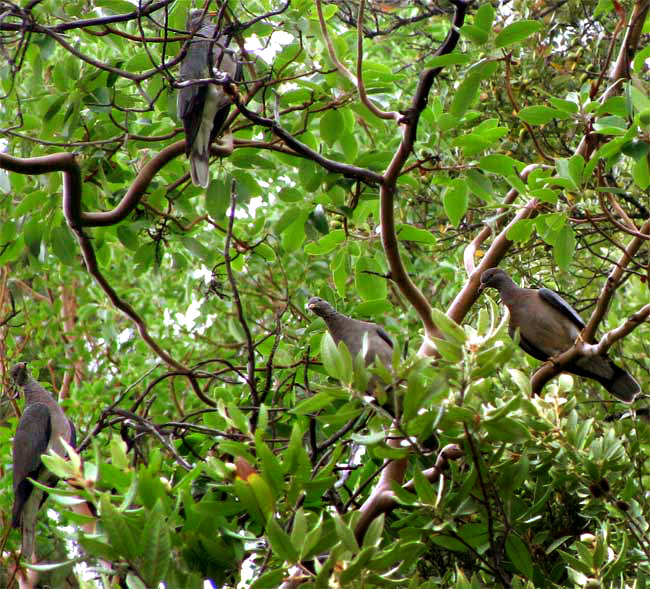Excerpts from Jim Conrad's
Naturalist Newsletter

from the the September 20, 2009 Newsletter, issued from the Siskiyou Mountains west of Grants Pass, Oregon:
PIGEONS AT DUSK
This week in the mountains I camped overnight at the edge of a cliff overlooking a valley opening onto a pretty bend of the Rogue River. At dusk I lay on my belly at the tent's door enjoying the view when a low-flying squadron of about ten pigeons winged up the valley, swooped within spitting distance of my tent and landed in a big Madrone right behind me.
City pigeons, sometimes called Rock Doves, come in all kinds of colors and patterns, but these birds -- clearly pigeons because of their big bodies with small heads and flocking behavior -- looked all the same. Also they lacked the Rock Doves' white lower back, or "rump," and they seemed larger. When landing, their fanned tails displayed white feather-tips that formed narrow, white tail-bands. The birds were curious about my tent, stretching their necks gawking at it first with one side of their head then the other, then flying to another tree and looking some more. You can see four of them giving me the eye at the top of this page.
They were Band-tailed Pigeons, COLUMBA FASCIATA. Field guides show the birds with conspicuous white crescents on their napes but these birds didn't have that. The crescent is absent on juveniles, so I'm guessing that that day I was visited by "a bunch of teenagers out exploring."
The birds visited several oaks around my tent seeming to feed, but it was too dark and my eyes were too weak to see what or how they were eating. I read that at this time of year flocks of up to 50 become nomadic, following the acorn crop, and acorns are listed as one of their prime foods. They store acorns in their crops, the literature says, which suggests that they swallow the acorns whole. With such small beaks and slender necks, that's something I'd like to see.
Band-tailed Pigeons range from British Columbia, Utah, and Colorado south in higher elevations through Mexico and Central America to northern Argentina. They're hunted in much of their southern area and since the 1960s even in North America their numbers have declined steadily at a rate of about 2.5% per year, and it's not understood why.